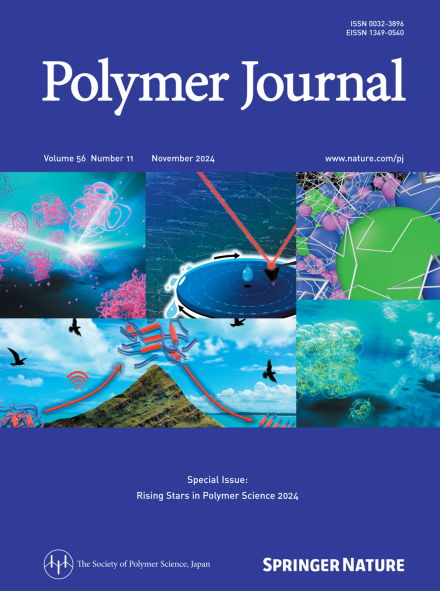无表面活性剂偶联聚合法制备聚吡咯及其衍生物纳米颗粒
IF 2.7
4区 化学
Q3 POLYMER SCIENCE
引用次数: 0
摘要
用固体Fe(NO3)3在水介质存在下对吡咯(Py)及其衍生物n -甲基吡咯(MPy)和n -乙基吡咯(EPy)进行了无表面活性剂偶联聚合,得到了聚合物颗粒的水分散体。动态光散射研究表明,Py、MPy和EPy体系在水介质中分别制备了粒径为153-206 nm、262-294 nm和273-278 nm的胶体稳定聚合物纳米颗粒。聚n -甲基吡咯(PMPy)和聚n -乙基吡咯(PEPy)的粒径大于聚吡咯(PPy),这可能是由于MPy和EPy的疏水性大于Py。粒子可以通过静电稳定机制实现胶体稳定性,因为聚合过程通过掺杂向聚合物引入阳离子。由于MPy和EPy的氧化还原电位比Py低,更容易过氧化,因此在PMPy和PEPy中引入了大量的羟基和羰基。此外,所得到的颗粒可以吸附在油水界面上,并作为有效的pickering型乳化剂。用聚吡啶和聚吡啶稳定的乙烯基水包覆聚合物乳液进行悬浮聚合,制备出粒径分别为25 μm和154 μm的纳米包覆聚合物微粒。通过气相偶联聚合,成功合成了表面无表面活性剂的聚吡咯、聚(n -甲基吡咯)和聚(n -乙基吡咯)纳米颗粒。粒子可以通过静电稳定机制实现胶体稳定性,因为聚合过程通过掺杂向聚合物引入阳离子。颗粒能吸附在油水界面上,是有效的pickering型乳化剂。乙烯基单体在水中的悬浮聚合与纳米颗粒稳定的Pickering乳剂产生了纳米颗粒包覆的聚合物微粒。”本文章由计算机程序翻译,如有差异,请以英文原文为准。

Synthesis of polypyrrole and its derivative nanoparticles via a surfactant-free coupling polymerization protocol
Surfactant-free coupling polymerization of pyrrole (Py) and its derivatives, namely, N-methylpyrrole (MPy) and N-ethylpyrrole (EPy), was conducted using solid Fe(NO3)3 in the presence of an aqueous medium, resulting in aqueous dispersions of polymer particles. Dynamic light scattering studies revealed the production of colloidally stable polymer nanoparticles with diameters of 153–206 nm, 262–294 nm and 273–278 nm in aqueous media for the Py, MPy and EPy systems, respectively. The particle sizes of poly(N-methylpyrrole) (PMPy) and poly(N-ethylpyrrole) (PEPy) were larger than those of polypyrrole (PPy), which could be due to the greater hydrophobicity of MPy and EPy than Py. The particles could achieve colloidal stability through an electrostatic stabilization mechanism, as the polymerization process introduces cationic charges to the polymers via doping. Larger amounts of hydroxy and carbonyl groups were introduced into PMPy and PEPy because of the easier overoxidation of MPy and EPy due to their lower redox potentials than that of Py. Furthermore, the resulting particles could adsorb on oil‒water interfaces and work as effective Pickering-type emulsifiers. Suspension polymerization of vinyl monomer-in-water Pickering emulsions stabilized with PPy and PMPy nanoparticles resulted in the production of nanoparticle-coated polymer microparticles with diameters of 25 μm and 154 μm, respectively. “Polypyrrole, poly(N-methylpyrrole) and poly(N-ethylpyrrole) nanoparticles with surfactant-free clean surfaces were successfully synthesized via a vapor-phase coupling polymerization protocol. The particles could achieve colloidal stability through an electrostatic stabilization mechanism, as the polymerization process introduces cationic charges to the polymers via doping. The particles could adsorb on oil‒water interfaces and work as effective Pickering-type emulsifiers. Suspension polymerization of vinyl monomer-in-water Pickering emulsions stabilized with the nanoparticles resulted in the production of nanoparticle-coated polymer microparticles.”
求助全文
通过发布文献求助,成功后即可免费获取论文全文。
去求助
来源期刊

Polymer Journal
化学-高分子科学
CiteScore
5.60
自引率
7.10%
发文量
131
审稿时长
2.5 months
期刊介绍:
Polymer Journal promotes research from all aspects of polymer science from anywhere in the world and aims to provide an integrated platform for scientific communication that assists the advancement of polymer science and related fields. The journal publishes Original Articles, Notes, Short Communications and Reviews.
Subject areas and topics of particular interest within the journal''s scope include, but are not limited to, those listed below:
Polymer synthesis and reactions
Polymer structures
Physical properties of polymers
Polymer surface and interfaces
Functional polymers
Supramolecular polymers
Self-assembled materials
Biopolymers and bio-related polymer materials
Polymer engineering.
 求助内容:
求助内容: 应助结果提醒方式:
应助结果提醒方式:


